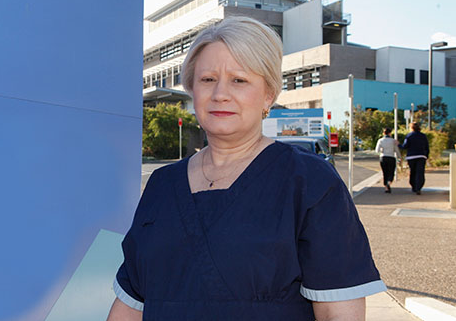Nurses across NSW are calling for better nurse-to-patient ratios in order to raise the quality of care of patients as well as the wellbeing of nurses themselves.
Officially launching their campaign last week, NSW Nurses and Midwives Association (NSWNMA) is urging the Government to make nurse-to-patient ratios law.
Branch Secretary from the NSWNMA Nepean Hospital branch, Debbie Renshaw, said the current workload nurses were experiencing at Nepean needed to change.
“Nurses are getting exhausted, they are getting burnt out,” she said.
“You are just chasing your tail from the beginning to the end of the shift and you’re just trying to put out spot fires the whole shift.”
Working at Nepean Hospital for almost 20 years, Ms Renshaw said that it hadn’t always been this way.
“At the start of my career you had so much more time and when you came home from work each day you actually felt like you did a nice job,” she said.
“Now you could have seven high risk patients and it only takes one patient to become unwell and you won’t get your meal break, you’ll get off late because you don’t want to leave those patients stranded.
“When you come home from work, you’re glad your patients are still alive because you think of so many things you should have done.”
In 2011, the NSWNMA won some mandated nurse-to-patient ratios, but since then the NSW Government has not delivered a second phase of ratios to extend them to rural and regional hospitals or into specialty areas, such as emergency departments, critical care units or paediatrics.
But a Nepean Hospital spokesperson said that safe and effective staffing in nursing and midwifery involved more than just numbers of staff.
“It is about making sure we have the right number of staff in the right place at the right time and adjusting staffing to meet activity and patient complexity,” the spokesperson said.
“Nepean Hospital uses this method as it allows flexibility to allocate nursing hours in a way that matches the busiest times and patient needs.”
And while Ms Renshaw said she was often deployed to other wards, it didn’t necessarily mean for a better shift.
“I was deployed to a different ward and we had 17 patients between three staff, with eight needing hourly observations,” she said.
“But it wasn’t just myself from a different ward, one nurse hadn’t worked with adults for 30 years and the other was a junior nurse, it was a terrible shift.”
With Victoria and Queensland already making nurse-to-patient ratios law, General Secretary of the NSWNMA, Brett Holmes, said the link between nurse staffing levels and improved patient outcomes could no longer be ignored.
“Research has shown that every additional patient per nurse can increase the likelihood of an inpatient dying by seven per cent,” he said.
“Nurses are some of our most valued workers who do the best they can in impossible circumstances, so why won’t this government stand by them and their patients by introducing improved ratios?”
Lauren Suttie is the Weekender’s General & Community News journalist.


